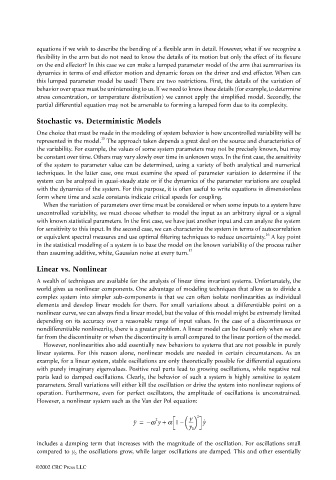Page 691 - The Mechatronics Handbook
P. 691
0066-frame-C22 Page 10 Wednesday, January 9, 2002 6:22 PM
equations if we wish to describe the bending of a flexible arm in detail. However, what if we recognize a
flexibility in the arm but do not need to know the details of its motion but only the effect of its flexure
on the end effector? In this case we can make a lumped parameter model of the arm that summarizes its
dynamics in terms of end effector motion and dynamic forces on the driver and end effector. When can
this lumped parameter model be used? There are two restrictions. First, the details of the variation of
behavior over space must be uninteresting to us. If we need to know these details (for example, to determine
stress concentration, or temperature distribution) we cannot apply the simplified model. Secondly, the
partial differential equation may not be amenable to forming a lumped form due to its complexity.
Stochastic vs. Deterministic Models
One choice that must be made in the modeling of system behavior is how uncontrolled variability will be
15
represented in the model. The approach taken depends a great deal on the source and characteristics of
the variability. For example, the values of some system parameters may not be precisely known, but may
be constant over time. Others may vary slowly over time in unknown ways. In the first case, the sensitivity
of the system to parameter value can be determined, using a variety of both analytical and numerical
techniques. In the latter case, one must examine the speed of parameter variation to determine if the
system can be analyzed in quasi-steady state or if the dynamics of the parameter variations are coupled
with the dynamics of the system. For this purpose, it is often useful to write equations in dimensionless
form where time and scale constants indicate critical speeds for coupling.
When the variation of parameters over time must be considered or when some inputs to a system have
uncontrolled variability, we must choose whether to model the input as an arbitrary signal or a signal
with known statistical parameters. In the first case, we have just another input and can analyze the system
for sensitivity to this input. In the second case, we can characterize the system in terms of autocorrelation
16
or equivalent spectral measures and use optimal filtering techniques to reduce uncertainty. A key point
in the statistical modeling of a system is to base the model on the known variability of the process rather
17
than assuming additive, white, Gaussian noise at every turn.
Linear vs. Nonlinear
A wealth of techniques are available for the analysis of linear time invariant systems. Unfortunately, the
world gives us nonlinear components. One advantage of modeling techniques that allow us to divide a
complex system into simpler sub-components is that we can often isolate nonlinearities as individual
elements and develop linear models for them. For small variations about a differentiable point on a
nonlinear curve, we can always find a linear model, but the value of this model might be extremely limited
depending on its accuracy over a reasonable range of input values. In the case of a discontinuous or
nondifferentiable nonlinearity, there is a greater problem. A linear model can be found only when we are
far from the discontinuity or when the discontinuity is small compared to the linear portion of the model.
However, nonlinearities also add essentially new behaviors to systems that are not possible in purely
linear systems. For this reason alone, nonlinear models are needed in certain circumstances. As an
example, for a linear system, stable oscillations are only theoretically possible for differential equations
with purely imaginary eigenvalues. Positive real parts lead to growing oscillations, while negative real
parts lead to damped oscillations. Clearly, the behavior of such a system is highly sensitive to system
parameters. Small variations will either kill the oscillation or drive the system into nonlinear regions of
operation. Furthermore, even for perfect oscillators, the amplitude of oscillations is unconstrained.
However, a nonlinear system such as the Van der Pol equation:
y
ÿ = −w y + a 1 – 2 y ˙
2
----
y 0
includes a damping term that increases with the magnitude of the oscillation. For oscillations small
compared to y 0 the oscillations grow, while larger oscillations are damped. This and other essentially
©2002 CRC Press LLC

